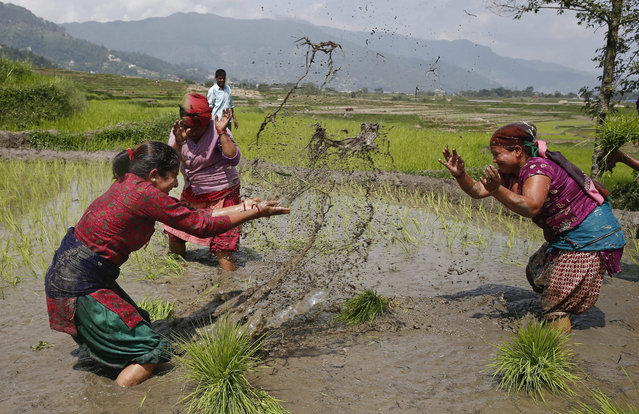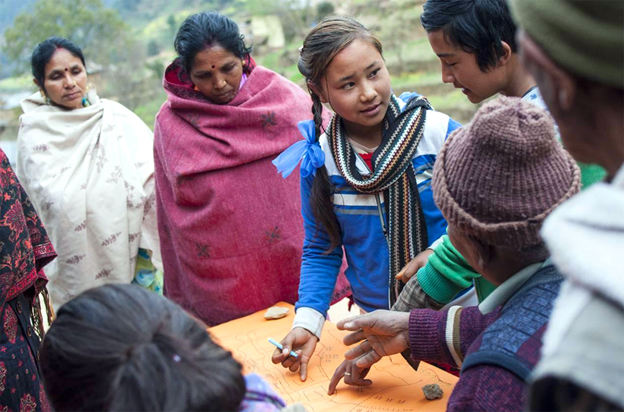The meetings took place at NACCFL’s headquarters, in a pleasant residential area on the hills of Lalitpur, near Kathmandu, where 20 professionals gathered to discuss actions in preparation of the Learning Routes. Local Champions, replicators, cooperative managers and leaders came from Nepal’s Eastern and Central regions to meet with NACCFL’s leadership and a small team from Procasur to answer the first questions:
Where to find strong themes for the Learning Routes?
And how to select the Local Champions who share their solutions with specific target groups?
Through an interactive exercise to try and sell local knowledge, the Eastern and Central regions mapped their strong points and evaluated each other’s proposals.
EASTERN REGION’S PROPOSAL FOR LEARNING ROUTES (SFACL Maharanijhoda)
The strongest point of the SFACL Maharanijhoda, as everyone agreed, is the cooperative farming model, the first of its kind in Nepal, which already aroused the interest of the Nepali government for replication. The cooperative farming model targets lowland farmers where land pooling is possible.CENTRAL REGION’S PROPOSAL FOR LEARNING ROUTES (SFACL Hadikhola and Manahari)The Small Farmer Agricultural Cooperatives of Hadikhola and Manahari are both women led and chaired by young ladies. In Hadikhola, out of the cooperative’s 2100 members only 6 are male. But this alone does not make them unique in Nepal, where many cooperatives are women based. Their strongest points include integrated farming, lift irrigation, and the only social theme for indigenous groups, the cooperative involvement of the almost extinct Bankariya people.
Poster at NACCFL headquarters
showing cooperative organization structure.
NACCFL’s three-tiered cooperative organization structure starts with the Small Farmer groups, featured on the top of the tree. Through their Village Councils (white circles), they each send one representative to an inter-group at ward level (red circles). In average, 9 wards make up a Village Development Committee (VDC, blue circle), where the wards send elected leaders to form a Cooperative Board. Since VDCs in Nepal have been gradually merging, VDC level cooperatives boast thousands of members who benefit from financial and non-financial assistance, livestock insurance, infrastructural development and women empowerment.
“We are planning two Learning Routes, one on national level and a second one for international participants”, said Mr. Trijan Singh, Assistant Programme Manager at NACCFL. “In these parts, innovations and solutions are poorly documented and not recognized”, he said while welcoming the systematic approach of Procasur’s Learning Route methodology.
In his rundown on the Learning Routes, Mr. Ariel Halpern, Vice-President of Procasur emphasized the recognition and access of farmers’ innovations.
“Only 5-15% of the farmers have access to innovations and technical assistance services worldwide. But the farmers’ knowledge is available, affordable and accessible for others.”
As an outstanding example from Latin-America, where Procasur’s Learning Routes first initiated, Mr. Halpern cited the government of Peru, which adopted a new policy for farmer-to-farmer training, and Local Champions are now recognized as service providers.
There is a problem worldwide with innovations being too far and widely spaced, and there is little investment in research and documentation of innovations that farmers own. To address this problem, “we need to work with Local Champions to find and promote local solutions for their wider outreach”, said Mr. Halpern.
Q: “While the investments in Learning Routes are obvious, regarding time, effort, commitment and travel, but what are the benefits?” A: “On cooperative level, financial benefits include payment for case studies, for replication and for trainings. This is also a solution for documentation and valorization of the knowledge.
There are also numerous technical benefits in knowledge management and identification of innovations, best practices and Local Champions as owners. The programme ultimately provides trained professionals for replication and dissemination. Also, NACCFL will be part of an international network that shares information.”
Following an earlier Learning Route in Nepal’s northwestern region, the impact of ROUTASIA’s learning method is beyond doubt. “In 2 years we registered massive changes in Kapilvastu District, largely thanks to the comfort the farmers found in peer-to-peer learning”, explained Mr. Dhruba Regmi, Procasur’s focal point in Nepal, who worked more than 7 years with small farmer cooperatives in Nepal. “Most cooperatives are invisible, and Learning Routes offer a lot of opportunities for exposing themselves, for learning and for replication.”
![]() |
| Learning Route to Rayale VDC Leasehold Forest User Groups cluster in February, 2013 |
PROFILESmall Farmer Agriculture Cooperative, Maharanijhoda VDC, Jhapa District
Eastern Region This women-only cooperative was established in 1999 within the NACCFL network, and now provides financial and non-financial services to its 1531 female members. They have been involved in a variety of agribusiness activities, such as integrated farming, seed production, milk production and marketing. The cooperatives innovative integrated farming involves 49 households who benefit from good irrigation, mechanization, collective marketing and improved production. “We started with many types of crops and merging fragmented lands. Through the innovations we achieved higher profit and lower costs. Our cooperative just opened a seed processing center which creates higher value than only rice growing.
– Ms. Mina Kumari Dhakal, Chairperson of SFACL Maharanijhoda
![]()
Land fragmentation in Nepal: With 64% of households engaged in farming countrywide, land fragmentation is one of the main causes of food insecurity in Nepal.
One of the biggest challenges for small farmers in Nepal, especially the young generation, is land fragmentation due to legal restrictions and the very common land inheritance disputes. Land is the main family asset in Nepal that is also used as collateral for temporary loans and as a source of investment. Access to land is a symbol of wealth, status and power.
“Land fragmentation also drives outmigration, which is a big problem in rural areas, affecting a large portion of our youth who shift to migrant workers”, said Mr. Tirtha Raj Ojha, Manager of SFACL Maheshpur of the Eastern region. “The question is, how to bring back the people?”
The answer lies in cooperative farming, farmer-to-farmer learning and the opportunities in Learning Routes. Many farmers, including rural youth, started to come back to the Eastern Region to invest in high value production of spices and fruits. They use land management by putting fragmented pieces together. Within the Maheshpur Small Farmer Cooperative, merged lands create high diversity and quality by letting each farmer grow one crop they are experts of.
PROFILEThe concept of Lead Farmers
Central Region Choosing the right farmer leaders or Local Champions is essential in planning the Learning Routes. In Makawanpur District in the Central region, the Small Farmer Agricultural Cooperatives of Hadikhola and Manahari perfected their own system for identifying “lead farmers”. Since 2 years, they have been trained 25 farmer leaders at district level to open an agriculture school. The lead farmers identify people to be trained, 20 students for one trainer.
Into the group of these 25 lead farmers, 2 are selected from each ward. They are trained, and the top 2-3 are picked out as resource persons with leadership qualities.
“In the final stage, lead farmers run their own field trainings but there is no emphasis on follow-up. While cooperatives and their replications are running smoothly, we welcome ROUTASIA’s assistance in sustainability.”
– Mr. Deewakan Rupakheti, Manager of District Agricultural Federation, Makawanpur
With the Local Champions and their solutions identified to be featured on the Learning Routes, NACCFL, Procasur and both regions agreed that the first LR should choose the Central Region as its destination. The Route is scheduled for the end of the year.
In the meantime, as part of the mutual agreement, participatory case studies are being prepared for the cases identified for LR exposure.
ROUTASIA is looking forward to the next steps in its partnership with NACCFL and the Small Farmer Cooperatives towards successful Learning Routes that can bring recognition to local solutions and their owners.



